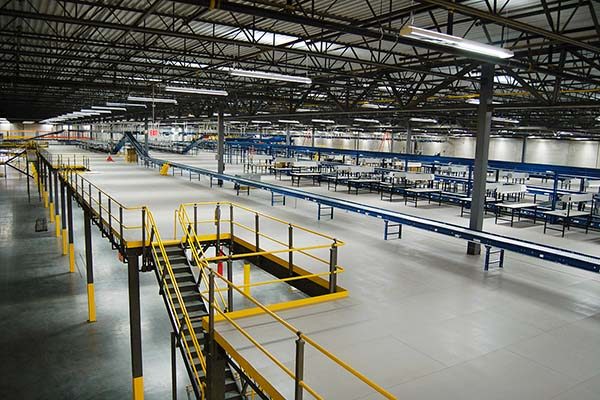Mezzanines make the difference
Warehouse automation projects are spurring demand for industrial work platforms as facilities require more space and access to complex material handling systems.

Industrial work platforms haven’t changed much in the past 10 or 20 years, but that doesn’t mean these warehouse staples should be an afterthought in today’s modern workspaces. On the contrary, as warehouses and distribution centers (DCs) become more automated, experts say demand is on the rise for steel support structures that can be integrated with the latest material handling technologies.
“The trend toward automation has really increased the need for platforms—and we’re seeing it at a much larger scale,” says John Murphy, key account sales manager for Waukesha, Wisconsin-based Wildeck, which makes steel work platforms, industrial lifts, and related material handling equipment. “[Today’s] DCs are huge; we’re talking a million square feet sometimes. The larger footprint creates a greater need for our projects.”
That's because work platforms, also called mezzanines, can support personnel and the increasing array of automated equipment in those large facilities while also providing access to the equipment and systems for service and routine maintenance. This is especially helpful in e-commerce environments, where companies are storing more products, processing orders at a higher rate, and striving to get packages out the door faster than ever before.
“Companies have [high] throughput goals, and automation is helping with that,” Murphy adds, emphasizing the growing demand for platforms that support conveyors, automated storage and retrieval systems (AS/RS), and robotic picking solutions that are augmenting human labor in the warehouse. “In many cases, you’re dealing with a small labor pool, so it’s important to automate. I definitely see this as a trend—and something that is driving growth in our business.”
MAKING SPACE FOR WORK
Mezzanines have long been used for basic needs in the warehouse: providing extra space for shelving, connecting catwalks throughout a facility, or supporting more racking solutions, including pick modules. They continue to fill those roles, simultaneously helping companies take advantage of ceiling height to maximize storage space and create clearance for work to be done underneath. Today, mezzanines and platforms are commonly used to create multilevel pick zones in a warehouse or DC and to support conveyors throughout a facility. And increasingly, they are being used to support robotic picking operations, especially those that incorporate autonomous mobile robots (AMRs).
Daniel Aguirre, sales manager for steel rack manufacturer Nucor Warehouse Systems, offers one example: Small AMRs that resemble Kiva- or Roomba-style robots are often combined with mobile shelving units to form a goods-to-person picking system, he says. The robots are programmed to move orders directly to workers by traveling through the aisles of a warehouse storage area, identifying the correct shelf of products, positioning themselves under the shelf, and then transporting the shelf to a picking station, where human workers fill orders. Aguirre explains that many companies are finding it easy to add mezzanines to the system to support the robots and shelf units, opening up floor space below for additional picking and other tasks.
“[This is] where we’re headed, and what we’re seeing more of,” Aguirre explains.
French warehouse automation company Scallog says customers are beginning to use its goods-to-person AMR solution in this way, creating up to 30% more picking space in a facility and tripling worker productivity. The system can be implemented either above or below a mezzanine: Scallog’s “Boby” robots, shelving units, and picking stations can be housed either on the main floor (with storage above, on the mezzanine) or on the mezzanine itself, with storage and additional picking space below. In both cases, the two levels are connected by a vertical conveyor. Scallog has implemented about a dozen such solutions to date, according to Remi Badaroux, the company’s international business developer.
Variations of this configuration are widely used in large DCs, primarily due to their scalability and because they don’t require major infrastructure changes. The equipment doesn’t need to be anchored to the ground, so the system can be installed easily using the space-saving platforms and mezzanines.
“This is definitely a growing space, especially with labor costs going up and infrastructure costs going up,” Aguirre says, referring to automation in general and the accompanying demand for racking, storage, and platforms to support it. “The return on the investment in automation systems is more validated [today]. So we are seeing more Fortune 500 companies looking to implement these systems in the next one to five years.”
PROVIDING ACCESS FOR MAINTENANCE
Work platforms are also commonly used to provide maintenance access to machinery and equipment in a facility, especially in manufacturing environments. The arrival of automated high-tech material handling systems is making this a more common application in the warehouse and DC as well. Automated storage and retrieval systems are a case in point: These high-density storage solutions are a mixture of software, controls, robotics, and hardware that shuttle products to picking stations for order fulfillment. Although they are programmed to run like a well-oiled machine, the systems require regular maintenance and occasional troubleshooting. And because the systems can take up considerable vertical space in a building—the grid-based AutoStore AS/RS can stand as high as 25 feet, for instance—they need support structures that can grant access to technicians and provide workspace for system monitoring.
“With some of the robotic systems we’re seeing—like AutoStore—our platforms are primarily service-access platforms,” Murphy, of Wildeck, explains. “We’ve done a lot of these recently, along with more comprehensive conveyor layouts.”
Mezzanines are frequently used to support conveyors and other equipment running through a warehouse or DC, for both safety and space-saving reasons, Murphy adds. They can be custom-built to support a project—some can be thousands of square feet in size—and they essentially put the conveyor system above the main floor of a facility, creating more workspace below and keeping workers from coming into contact with the machinery. Only those employees who need to access the automated equipment can get to it.
“Our systems support conveyors, scanners, sortation systems—and we’re seeing so much more of it, especially since Covid,” Murphy says, pointing to the acceleration of e-commerce over the past three years and the resulting demand for more automation in those ever-larger DCs that companies like Amazon, Walmart, and Target have built.
Wildeck recently moved into a 330,000-square-foot headquarters and manufacturing facility in Waukesha—which is three times the size of the company’s previous facility—to accommodate growing demand for its products.
“We’re at an exciting time in our industry,” Murphy says. “Many companies are working to set themselves up for future demand, and we see the automation trend continuing to grow [as a result]. And we’re happy to be a part of it.”Related Articles

Copyright ©2024. All Rights ReservedDesign, CMS, Hosting & Web Development :: ePublishing